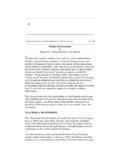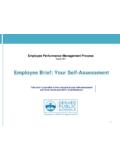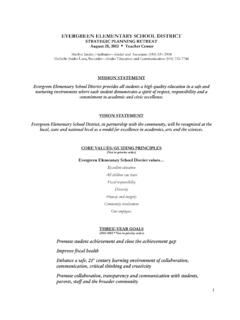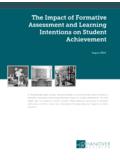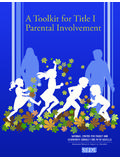Transcription of Reducing the Racial Achievement Gap: A Social ...
1 Reducing the Racial Achievement Gap: A. Social -Psychological Intervention Geoffrey L. Cohen, et al. Science 313, 1307 (2006);. DOI: This copy is for your personal, non-commercial use only. If you wish to distribute this article to others, you can order high-quality copies for your colleagues, clients, or customers by clicking here. Permission to republish or repurpose articles or portions of articles can be obtained by following the guidelines here. The following resources related to this article are available online at (this information is current as of June 28, 2010 ): Updated information and services, including high-resolution figures, can be found in the online version of this article at: Downloaded from on June 28, 2010. Supporting Online Material can be found at: A list of selected additional articles on the Science Web sites related to this article can be found at: #related-content This article cites 9 articles, 1 of which can be accessed for free: #otherarticles This article has been cited by 42 article(s) on the ISI Web of Science.
2 This article has been cited by 12 articles hosted by HighWire Press; see: #otherarticles This article appears in the following subject collections: Psychology Science (print ISSN 0036-8075; online ISSN 1095-9203) is published weekly, except the last week in December, by the American Association for the Advancement of Science, 1200 New York Avenue NW, Washington, DC 20005. Copyright 2006 by the American Association for the Advancement of Science; all rights reserved. The title Science is a registered trademark of AAAS. REPORTS. DUF1220-coding potential of the human brain, 2. Chimpanzee Sequencing and Analysis Consortium, Nature 19. J. M. Sikela, PLoS Genet. 2, e80 (2006). suggesting that such an increase may have 437, 69 (2005). 20. J. E. Horvath et al., Genome Res. 15, 914 (2005). 3. Rhesus Monkey Genome Project, Baylor College of 21. We thank S. Burgers, J. Chang, A. Blackler, A. Fortna, conferred strong selective advantages.
3 Medicine Human Genome Sequencing Center A. Solidar, J. Smith, and B. Carstens for technical help;. The genomic regions that harbor DUF1220 ( ). D. Manchester, M. Churchill, J. Pollack, Y. Kim, and sequences appear to be particularly complex and, as 4. J. Cheung et al., Genome Biol. 4, R25 (2003). J. Kent for helpful discussions; L. Jorde for providing a result, different genome assemblies differ with 5. J. R. Pollack et al., Nat. Genet. 23, 41 (1999). genomic DNAs from diverse human populations; the 6. Human Genome Sequencing Consortium, Nature 431, Macaque Genome Sequencing Consortium for generating respect to the predicted number of DUF1220- 931 (2004). genome sequence assemblies and making data available encoded sequences. However, two recent genome- 7. A. Fortna et al., PLoS Biol. 2, e207 (2004). before publication; B. K. DeMasters and Sze for wide BAC aCGH cross-species studies (17, 18) 8. K. Vandepoele, N. Van Roy, K.
4 Staes, F. Speleman, providing postmortem human brain tissue; R. Levinson independently support the findings reported here F. van Roy, Mol. Biol. Evol. 22, 2265 (2005). for immunocytochemical expertise and for use of light 9. A. Bateman et al., Nucleic Acids Res. 32, D138 (2004). microscopy facilities; and J. Caldwell for assistance with that DUF1220-encoding genes show human 10. E. L. L. Sonnhammer, S. R. Eddy, R. Durbin, Proteins 28, interpretation of immunofluorescence results. Supported lineage specific increases in copy number and 405 (1997). by a Butcher Foundation grant and NIH grant AA11853. appeared with remarkable rapidity. If they indeed 11. S. G. Gregory et al., Nature 441, 315 (2006). ( ) and the University of Missouri Research Board are the result of strong positive selection, they may 12. I. Verde et al., J. Biol. Chem. 276, 11189 (2001). ( ). 13. D. L. Swofford, PAUP: Version 4 (Sinauer Associates, play an important role in human lineage specific Supporting Online Material Sunderland, MA, 1998).
5 Traits (19) and serve to illustrate how certain 14. M. Kreitman, Annu. Rev. Genomics Hum. Genet. 1, 539 regions of the genome can undergo episodes of (2000). Materials and Methods Figs. S1 to S6. Bpunctuated[ evolution (20). 15. C. M. Malcom, G. J. Wyckoff, B. T. Lahn, Mol. Biol. Evol. Tables S1 to S8. 20, 1633 (2003). References Downloaded from on June 28, 2010. References and Notes 16. M. Goodman, Am. J. Hum. Genet. 64, 31 (1999). 1. S. Ohno, Evolution by Gene and Genome Duplication 17. V. Goidts et al., Hum. Genet. 119, 185 (2006). 5 December 2005; accepted 6 July 2006. (Springer, Berlin, 1970). 18. G. M. Wilson et al., Genome Res. 16, 173 (2006). characterizations can pose a chronic threat to Reducing the Racial Achievement Gap: self-integrity; third, such threat, if too severe, can undermine performance. A Social -Psychological Intervention School settings can be stressful to almost all students regardless of race.]
6 However, for African American students, the academic environment Geoffrey L. Cohen,1* Julio Garcia,2* Nancy Apfel,2 Allison Master2 involves an extra degree of threat not experienced by nonminority students, due to the negative Two randomized field experiments tested a Social -psychological intervention designed to improve stereotype about the intelligence of their race. minority student performance and increase our understanding of how psychological threat This threat, on average, raises stress to levels that mediates performance in chronically evaluative real-world environments. We expected that the risk are debilitating to performance (6 9). According- of confirming a negative stereotype aimed at one's group could undermine academic performance ly, we expect that a self-affirmation intervention in minority students by elevating their level of psychological threat. We tested whether such would be particularly effective at improving psychological threat could be lessened by having students reaffirm their sense of personal their academic performance.
7 We would, in fact, adequacy or self-integrity.'' The intervention, a brief in-class writing assignment, significantly expect this intervention to improve the perform- improved the grades of African American students and reduced the Racial Achievement gap by ance of all groups of individuals subjected to a 40%. These results suggest that the Racial Achievement gap, a major Social concern in the United threat sufficiently pervasive and intense to States, could be ameliorated by the use of timely and targeted Social -psychological interventions. impede that entire group_s average performance. This prediction was tested in two randomized he drive for self-integrity seeing oneself psychological threat not experienced by those out- double-blind field experiments (12). The second, T as good, virtuous, and efficacious is a fundamental human motivation (1 3). Membership in valued Social groups is often side their group. If too severe, stress can undermine performance (6 10).
8 Indeed, simply observing a group member who might confirm a negative a replication study, occurred a year after the first and involved a different cohort of students. Par- ticipants were seventh-graders from middle- to a major source of individuals_ sense of self- stereotype about one_s group can induce threat, lower-middle-class families at a suburban north- integrity (4, 5). Consequently, negative character- undermining performance (5). eastern middle school whose student body was izations of one_s group can prove threatening, One potentially effective way to buffer peo- divided almost evenly between African Ameri- especially in chronically evaluative environments. ple against threat and its consequences, we sug- cans and European Americans. The experiments Because people subjected to widely known gest, is to allow them to reaffirm their self-integrity involved 119 African American students and 124. negative stereotypes impugning the intelligence of (2, 3).
9 Self-affirmations, by buttressing self-worth, European American students distributed roughly their group are aware of these negative character- can alleviate the stress arising in threatening per- evenly across the two studies. All the teachers izations, they may worry that performing poorly formance situations (11). They can take the form who participated taught the same academic could confirm the stereotype of their group (6 8). of reflections on personally important, over- subject (one not typically related to gender This situation can create chronic stress at school arching values, such as the importance of family stereotypes). This subject was the intervention- and work, by burdening people with an extra or a self-defining skill (2, 3). targeted course in both studies; it was the one in The research reported here tested whether a which the intervention was administered. 1. Department of Psychology, University of Colorado, Muenzinger self-affirmation intervention designed to lessen In the fall term of each year, students were Psychology Building, Boulder, CO 80309 0345, USA.
10 2 Depart- threat would enhance the academic Achievement randomly assigned, at the level of the individual ment of Psychology, Yale University, 2 Hillhouse Avenue, New of negatively stereotyped minority students. The student, to the affirmation condition or the control Haven CT 06520, USA. intervention rested on three assumptions: First, condition. For each teacher and classroom period, *To whom correspondence should be addressed. E-mail: ( ); ( ). people are motivated to maintain self-integrity; there were approximately equal numbers of par- Present address: Department of Psychology, Stanford second, because group memberships are an im- ticipants in each condition. Teachers were blind to University, Stanford, CA 94305, USA. portant source of self-integrity, negative group students_ condition assignment and unaware of the SCIENCE VOL 313 1 SEPTEMBER 2006 1307. REPORTS. specific research hypothesis. The experimental treatment effect at varying levels of preintervention fall term of the targeted course in the three pre- treatment occurred as close to the start of the fall performance (averaged over both studies), illus- vious years (z G 1, NS).
